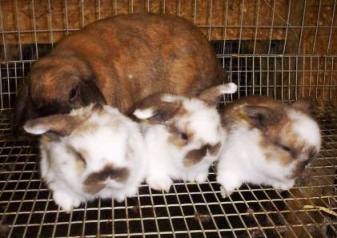Grooming Holland Lop Rabbits – Pets or For Show
Last Updated on May 22, 2012 by The Rabbit Smarties Team
by Laurie Stroupe.
 The first step to grooming, of course, is to keep a clean cage. It is important to brush the rabbit cages regularly and remove any fallen hay that will trap fecal matter and make for some really dirty feet. I think that genetics do play a part here, too. Some bunnies are just naturally cleaner than others. When you are brushing cages, you will come to some cages that are a mess (just since yesterday!) and others are sparkling clean after two weeks.
The first step to grooming, of course, is to keep a clean cage. It is important to brush the rabbit cages regularly and remove any fallen hay that will trap fecal matter and make for some really dirty feet. I think that genetics do play a part here, too. Some bunnies are just naturally cleaner than others. When you are brushing cages, you will come to some cages that are a mess (just since yesterday!) and others are sparkling clean after two weeks.
The next step is to remove stains. I find that peroxide works especially well on feed stains. I had a buck with such a short muzzle that he couldn’t eat without getting food on his forehead. Before every show, though, I could get it sparkling clean with peroxide. I’ve heard of people drying the peroxide with corn starch, but I never had to do that. I just let it dry naturally and then brushed the fur out.
Bunnies clean themselves daily just like cats do. Bathing a bunny in water (with or without regular shampoo) can remove its natural oils and will make the fur worse than it was in the beginning. I use a rinseless shampoo for stains only. After spraying the stained area with the shampoo, I use a towel to dry and then finish up with brushing.
For rabbits just starting into a molt or those who haven’t been brushed in awhile, nothing beats just rubbing down their bodies repeatedly with slightly damp hands. Shake the dead fur off your hands occasionally and continue until no more dead hair is being removed.
I also use an antistatic spray from FoxAllen Farm. It really allows the fur to show at its best. For longish hair that is flyaway, it is especially helpful. I just spritz a tiny bit into my hands and rub them almost dry, then backrub the fur. A bit of brushing and I have a very nice fur!
Use a metal bristled slicker for brushing. You can use a 4″ brush for the body and a smaller specialty brush for faces and tight spots.
Do not use horse preparations that leave a residue on the fur. It is against ARBA rules to change the fur artificially by any means other than grooming. There has been some discussion about what that means, but you are safe if you remove stains and dead fur, I believe, but do not coat your bunny with shiny additives! You can improve the look of the fur by simply barely dampening your hands with water and rubbing the fur. You will remove dead fur that way and distribute the naturally-occurring oils.
I know the following topic is not about fur, but I can’t finish talking about grooming without mentioning it: clip your rabbit’s nails. I admit, it was a skill I put off for as long as possible. I was afraid of cutting too deeply. But then I had a rabbit that ripped off a long nail in his cage. I figured that I couldn’t possibly hurt them as much as that hurt! So I dove in. Yes, I made some mistakes in the beginning (and still do), but it is much better for the bunnies to have their nails clipped for looks, for their proper foot balance, and for judging. Some judges will practically throw a long-nailed bunny off the table. Certainly, I’d be pretty sure no judge takes long nails positively.